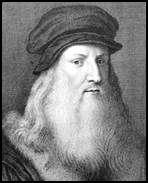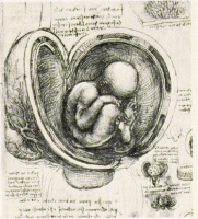 |
Leonardo da Vinci was, and still is, known as one of the greatest inventors and thinkers of the Italian Renaissance. He was an architect, musician, scientist, mathematician, and "inventor of genius." He was the prime example of the Renaissance's idea of a "whole and complete person." He especially excelled in science and art, and was always thinking outside of the box. Many of his ideas have been an inspiration for some modern technology.
The son of a wealthy Florentine lawyer and peasant girl, Leonardo da Vinci was born on April 15, 1452, in the City of Vinci, in what is now modern Italy. After his birth, da Vinci's father was quickly convinced to marry into a wealthy family, and his mother given to a cow herder.
Leonardo spent his early years on his father's farm in Italy. He loved nature and all of the animals living in the mountains by Vinci. His father recognized his son's immense intelligence and got him a job as an apprentice with the artist Verrocchio.
 |
He was an excellent apprentice and soon became the head of the workshop. Leonardo had a keen interest in how things worked. He had been interested in machines since he was a boy in Vinci. Although he hated war, he worked as a war engineer creating deadly and advanced weapons for the King of Milan.
It is thought that Leonardo didn't have many friends. He was a sculptor in Florence for awhile, and then he moved to Milan. He spent most of his life living in these cities. He felt he didn't fit in very well with the Florentine scholars and didn't like them. He also lived at the southern tip of France near Marseilles for awhile inventing and painting for the king there before he died.
Leonardo da Vinci was one of the greatest painters of the Italian Renaissance. He painted the Mona Lisa with her mysterious smile and his legendary interpretation of the Last Supper. He didn’t have a lot of paintings because it took him so long to paint a "great" painting; he was very careful and precise, and was always looking over his shoulder to make sure no one was copying him. He even went so far as to "mirror write," writing everything backwards, which was easy for him since he was left-handed. He also wrote backwards to prevent the powerful Roman Catholic Church from knowing about his scientific ideas. The Roman Church didn't approve of his thinking. Though most of his research and discoveries were great, he did not publish them, but we still have accounts of his great genius.
 |
His most famous and important discoveries were in human anatomy. The church wouldn't allow dissection on humans, so he cut up pigs instead. Leonardo was the first to believe that knowledge about the world must be based on scientific evidence from experiments. He also knew mathematics was an important part of science. Many of his scientific investigations failed because there were no accurate instruments for his experiments and some math laws had not yet been discovered.
Leonardo da Vinci died on May 2, 1519 in Cloux, France, but his genius lives on in his ideas and work.
Page created on 8/2/2015 5:20:13 PM
Last edited 8/2/2015 5:20:13 PM

You can also check out Science Hero: Leonardo da Vinci by Alex and Kara.